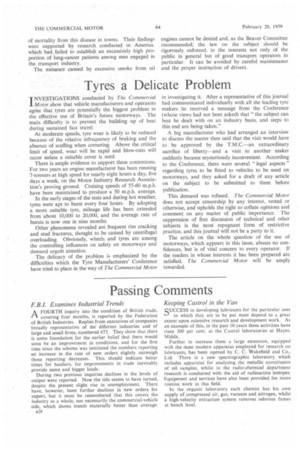Tyres a Delicate Problem
Page 32

If you've noticed an error in this article please click here to report it so we can fix it.
INVESTIGATIONS conducted by The Commercial Motor show that vehicle manufacturers and operators agree that tyres are potentially the biggest problem in the effective use of Britain's future motorways. The main difficulty is to prevent the building up of heat during sustained fast travel.
At moderate speeds, tyre wear is likely to be reduced because of the relative infrequency of braking and the absence of scuffing when cornering. Above the critical limit of speed, wear will be rapid and blow-outs will occur unless a suitable cover is used.
There is ample evidence to support these contentions. For two years an engine manufacturer has been running 7-tonners at high speed for nearly eight hours a day, five days a week, on the Motor Industry Research Association's proving ground. Cruising speeds of 55-60 m.p.h. have been maintained to produce a 50 m.p.h. average.
In the early stages of the tests and during hot weather, tyres were apt to burst every four hours. By adopting a more suitable tyre, mileage life has been extended from about 10,000 to 20,000, and the average rate of bursts is now one in nine months.
Other phenomena revealed are frequent rim cracking and stud fractures, thought to be caused by centrifugal overloading. Obviously, wheels and tyres are among the controlling influences on safety on motorways and demand urgat attention.
The delicacy of the problem is emphasized by the difficulties which the Tyre Manufacturers' Conference have tried to place in the way of The Commercial Motor in investigating it. After a representative of this journal had communicated individually with all the leading tyre makers he received a message from the Conference (whose views had not been asked) that "the subject can best be dealt with on an industry basis, and steps to this end are being taken."
A big manufacturer who had arranged an interview to discuss the matter then said that the visit would have to be approved by the T.M.C.—an extraordinary sacrifice of liberty—and a visit to another maker suddenly became mysteriously inconvenient. According to the Conference, there were several "legal aspects" regarding tyres to be fitted to vehicles to be used on motorways, and they asked for a draft of any article on the subject to be submitted to them before publication.
This demand was refused. The Commercial Motor does not accept censorship by any interest, vested or otherwise, and upholds the right to collate opinions and comment on any matter of public importance. The suppression of free discussion of technical and other subjects is the most repugnant form of restrictive practice, and this journal will not be a party to it.
The article on the whole question of the use of motorways, which appears in this issue, abuses no confidences, but is of vital concern to every operator. If the readers in whose interests it has been prepared are satisfied, The Commercial Motor will be amply rewarded.








































































































